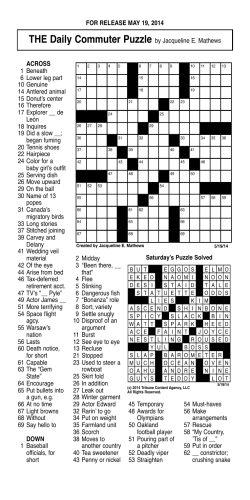
Crossword Puzzle - Homestead Museum
Objective: 1. To learn vocabulary words by using a popular 1920s game Time: 20-30 minutes Materials: 1. “Crossword Puzzle” activity sheet 2. Pencils Directions: Background information: The crossword puzzle was invented by Arthur Wynne in 1913. Wynne worked on the entertainment supplement of the New York World newspaper. Pressured to devise a new game, he recalled a Victorian-era word puzzle, Magic Square. Magic Square was a child’s game, frequently printed in 19th century British puzzle books and American penny periodicals. It consisted of a group of given words that had to be arranged so the letters read alike vertically and horizontally. It did not have any of the intricate word crisscrossings and blackened squares that Wynne built into his game. And where Magic Square gave a player the words to work with, Wynne created a list of Down and Across “clues,” challenging the player to deduce the appropriate words. On December 21, 1913, American readers were challenged with the world’s first crossword puzzle. The public loved it. ithin months, the crossword puzzle was appearing in other newspapers, and by the early 1920s, every major U. S. paper featured its own crossword puzzle. While other games have come and gone, crossword puzzles have continued to become more and more challenging. Regularly enjoyed by more than fifty million Americans today, the crossword puzzle is rated as the most popular indoor game in the country. From Panati’s Extraordinary Origins of Everyday Things by Charles Panati, 1987. 1. Distribute the “Crossword Puzzle” activity sheet. 2. Have students try to complete the puzzle without using their vocabulary sheets. If they need to refer to their vocabulary sheets, ask them to do so only after they have tried working on the puzzle without it. 3. After students have finished, discuss the answers to the questions (see Answer Key). Additional activity: 1. Building sentences: Have students try to create sentences using the puzzle words. Links to standards Language Arts: RF.4.3, L.4.4a-c, L.4.6 Homestead Museum: A Journey Through Time © Historical Resources, Inc. ADOBE AGRICULTURE APPLIANCE BOB BRAND CHARLESTON CLIMATE DECADE DROUGHT FIESTA HIDE INDUSTRY JAZZ MANUFACTURE RODEO STREETCAR TALLOW 1. A mark made on an animal’s skin to show to whom it belongs. 3. A period of ten years. 6. Raw materials are turned into finished products. 10. The average weather conditions of an area. 12. The making and selling of a good or service. 15. A popular dance in the 1920s. 16. A sun-dried brick made from clay, soil, straw, and water. 17. A short haircut on a woman. 2. A long period of time when there is little or no rainfall. 4. The science and business of growing crops and raising livestock. 5. Popular music in the 1920s and still popular today. 7. The skin of an animal. 8. A device, especially one operated by electricity and designed for using in a house. 9. A large car on rails for carrying people along the streets. 11. A large party or festival. 13. The roundup of a rancho’s cattle for branding or sale. 14. The animal fat from which soap and candles are made. Homestead Museum: A Journey Through Time © Historical Resources, Inc. Name _________________________________________________ Homestead Museum: A Journey Through Time © Historical Resources, Inc. Answer Key B R AND R O MA N U F G H A S T P T P R E L I E T A T N C A CH A R L E R L E BOB W J A Z Z S DE C ADE G C TU RE I H C I D U C L I MA T E F T I ND U S T R Y E R O E D S E T ON A D O BE A Homestead Museum: A Journey Through Time © Historical Resources, Inc.
© Copyright 2025













